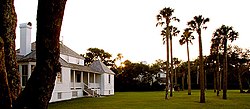Kingsley Plantation
|
Kingsley Plantation
|
|
 |
|
| Location | within the Timucuan Ecological and Historic Preserve, Jacksonville, Florida |
|---|---|
| Nearest city | Jacksonville, Florida, U.S. |
| Coordinates | 30°26′18″N 81°26′17″W / 30.43833°N 81.43806°WCoordinates: 30°26′18″N 81°26′17″W / 30.43833°N 81.43806°W |
| Area | 60 acres (24.3 ha) |
| Built | 1797 or 1798 |
| Architectural style | Other |
| NRHP Reference # | 70000182 |
| Added to NRHP | September 29, 1970 |
Kingsley Plantation (also known as the Zephaniah Kingsley Plantation Home and Buildings) is the site of a former estate in Jacksonville, Florida, that was named for an early owner, Zephaniah Kingsley, who spent 25 years there. It is located at the northern tip of Fort George Island at Fort George Inlet, and is part of the Timucuan Ecological and Historic Preserve managed by the U.S. National Park Service.
The plantation was originally 1,000 acres (4.0 km2), most of which has been taken over by forest; the structures and grounds of the park now comprise approximately 60 acres (242,811.385 m2). Evidence of Pre-Columbian Timucua life is on the island, as are the remains of a Spanish mission named San Juan del Puerto. Under British rule in 1765, a plantation was established that cycled through several owners while Florida was transferred back to Spain and then the United States. The longest span of ownership was under Kingsley and his family, a polygamous and multiracial household controlled by and resistant to the issues of race and slavery.
Free blacks and several private owners lived at the plantation until it was transferred to the State of Florida in 1955. It was acquired by the National Park Service in 1991. The most prominent features of Kingsley Plantation are the owner's house—a structure of architectural significance built probably between 1797 and 1798 that is cited as being the oldest surviving plantation house in the state—and an attached kitchen house, barn, and remains of 25 anthropologically valuable slave cabins that endured beyond the U.S. Civil War (1861–1865). The foundations of the house, kitchen, barn and the slave quarters were constructed of cement tabby, making them notably durable. Archeological evidence found in and around the slave cabins has given researchers insight into African traditions among slaves who had recently arrived in North America.
...
Wikipedia


